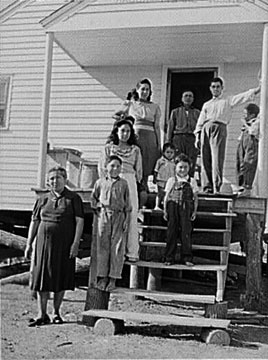
Since the 20th century, Latinos have had a significant role in America's economy. When the first Latinos arrived in 1915, Michigan was first entering the industrial revolution and there was a high demand for labor.1 Sugar companies were on the rise, and began recruiting their employees from Mexico and Southern Texas to tend the state's sugar beets. Those who did not work in the sugar beet fields found work maintaining railways and assembly lines in the automobile plants. Detroit, once populated by nearly all European immigrants was now home to 4,000 Mexican citizens by the end of 1920.2 Many workers came to Michigan to escape the violent racism of Southern Texas or the political unrest in Mexico in search of a better life. After a law was passed to restrict new immigration from Europe, the sugar beet industry soon became a dominant workforce heavily recruiting more and more laborers from Mexico. Sugar served first as a product consumed by the working urban class and suddenly became universal. Following the year 1920, a severe recession left the beet workers stranded in their camps with no work wages.3 As manufacturing jobs continued to move forward with the lay off of about eighty percent of the Mexican auto workers, most converted to construction or maintenance.4 By the end of the decade, 15,000 Mexicans and Mexican-Americans were living in Detroit, pursuing the “American Dream” the best way they could.5 Unfortunately the pursuit of the “American Dream” was not as easy as it seemed. Many people did not like the fact that the Latino population continued to increase. White supremacy and fear of losing jobs was a common thought among the non-Latino residents as well as the state's political elite. Racial discrimination in dance halls, barbershops, workplaces, and housing remained an obstacle to Latinos attempting to integrate themselves into American culture. Dark skinned Mexicans had more problems than the lighter skinned Mexicans because they could usually claim Spanish, Italian, and Native American heritage without problem. The 1930s, also known as the Great Depression, was a time of great economic pain causing families to go homeless and hungry.6 At the time, Michigan officials felt that they needed to come up with a solution for the lack of jobs reserved for “Americans”, and the solution was to execute a kind of “ethnic cleansing”, with the focus on the Mexican population.7 Instead of providing family assistance to Latino families, the Detroit welfare department, the federal government, and the Mexican Consulate collaborated to financially support the deportation of unemployed workers.8 This was also known as the Mexican Repatriation, where millions of American citizens were unjustly deported to Mexico between 1931 and 1933.9 As a result, the Detroit Mexican population decreased significantly from 15,000 to a mere 1,200.10 Even though times were tough for the citizens of Detroit, Mexican artist, Diego Rivera, was in the middle of his masterpiece, “Detroit Industry”.12 Commissioned by Edsel Ford to depict Ford Motor Company's River Rouge plant, he and his wife, Frida Kalho were enthusiastic supporters of the Detroit repatriation campaigns. Misinformed like many of the repatriates, he believed that people would have better lives and opportunities waiting for them upon their return to Mexico. When the repatriates finally arrived to their final destination, the Mexican government did not follow through with their promises, not even providing housing or food to the stranded families residing in the border towns. Families and individuals who did manage to find their way back to Detroit, had to start all over again and pick up what was left of their lives. After the depression, America had to find a way to jump start their construction, farms, and industries. Michigan's sugar industries were brought back into business through Roosevelt's New Deal, which guaranteed prices and new payments to sugar producers.13 The Roosevelt Administration also established minimum wages for all farm workers and child labor restrictions in 1937.14 Unfortunately, nothing was established to reinforce the new policies also the New Deal never guaranteed these rights to farm workers. As a result, manufacturers began to rely on smuggled laborers from Mexico, called Texicans in addition to white and southern black immigrants.15 By 1957, the population of migrant farm workers increased to 106,000 mostly through government programs, such as the Bracero Program.16 As the population increased, the quality of migrant camps that housed many families, decreased. There was no access to medical attention and very scarce nutritional resources. Soon enough, Diphtheria and Tuberculosis outbreaks occurred.17 In fear of further negative effects of immigration, the government launched “Operation Wetback”, where more Mexicans were deported once again back to Mexico.18 Although the presence of racist anti-immigrant hysteria in Michigan was strong, Mexicans chose to stay in Detroit because in the Southern states, like Texas, it was worse. Through the 60s, more workers joined union programs and began to settle in small or medium sized homes.19 |
